Introduction: Who was Fleming?
- Alexander Hugh Fleming was born at Lochfield Farm in Ayrshire, Scotland on 6th August 1881 (Mazumdar, 2004).
- Educated at Loudon Moor School, Darvel School, Kilmarnock Academy and the Royal Polytechnic Institution.
- Took an MBBS degree at St Mary’s Hospital Medical School, Paddington, between 1903 and 1906 and earned a BSc Degree in bacteriology in 1914.
- Served as a captain in the Royal Army Medical Corps in WW1 IN France and North Africa.
- Discouraged the use of antiseptics because it killed natural bacteria that protect wounds from infections.
- Discovered the enzyme “lysozyme” in 1921 (Hugh, 2002).
- Accidentally discovered penicillin, the cure for bacteria, in 1928.
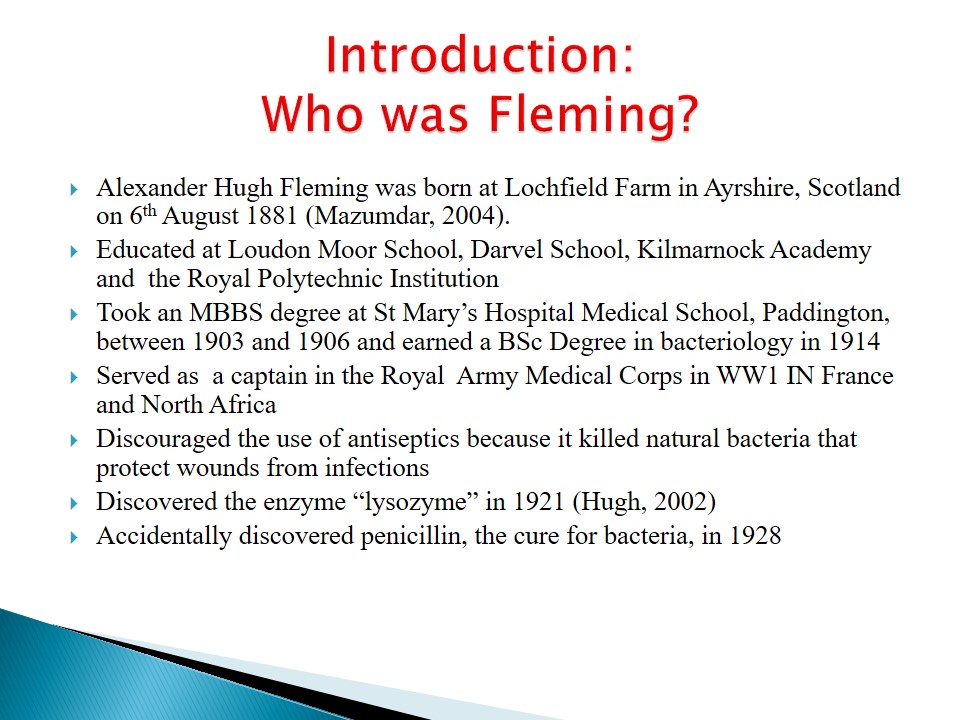
The Problem
- Previously, the existence of bacterium had been studied after the discovery by the French biologist Louis Pasteur years before Fleming.
- The major problem was how to kill pathogenic bacteria that infected millions of people around the world (Bennett & Chung, 2001).
- The major problem during the time was to treat infections in wounds that was killing thousands of soldiers during the first world war.
- Sulphonamides were the most popular antibiotics, including the Protonsil that had been discovered in Germany.
- However, sulphonamides were ineffective and the treatment caused many deaths.
- Most physicians were using antiseptics to treat wounds, but this increased the rate of infection by pathogenic bacteria.
- Fleming hypothesized that antiseptics were killing the natural microorganisms that were protecting the wounds from pathogenic infections.
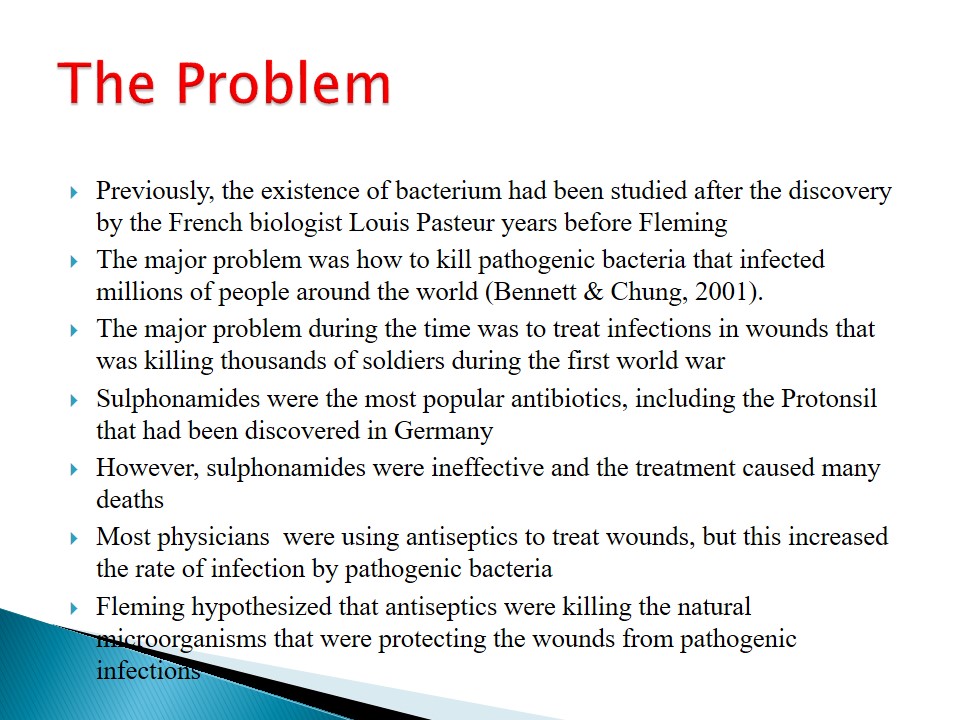
The experiment
- He left several cultures of the bacteria on a bench in his lab in August 1928 before leaving for a holiday.
- Returned on September 1928 and found colonies of fungi growing on the cultures.
- He realized that the colonies of Staphylococcus surrounding the fungus were being eliminated by the fungal growths on the media (McIntyre, 2007).
- Predicted that the fungi had some “funny” effect on the bacteria (Fleming, 1929).
- He replicated the experiment by growing pure fungi in new cultures and infect them with staphylococcus bacteria. He realized a substance released by the fungi was responsible for the death of the bacteria.
- On March 1929, he discovered “penicillin”, the fungal secretion that was responsible for the death of the bacteria.
- In 1929, he published his findings in the British journal of experimental pathology.
- However, it did not attract the attention of the scientific and medical community.
- Fleming thought that mass production of penicillin was not possible because of the difficulty in isolation and the slow growth of the fungi.
- He also thought that penicillin could not last long to kill bacteria once introduced in the body- it was an in vitro discovery (De la Bédoyère, 2005).
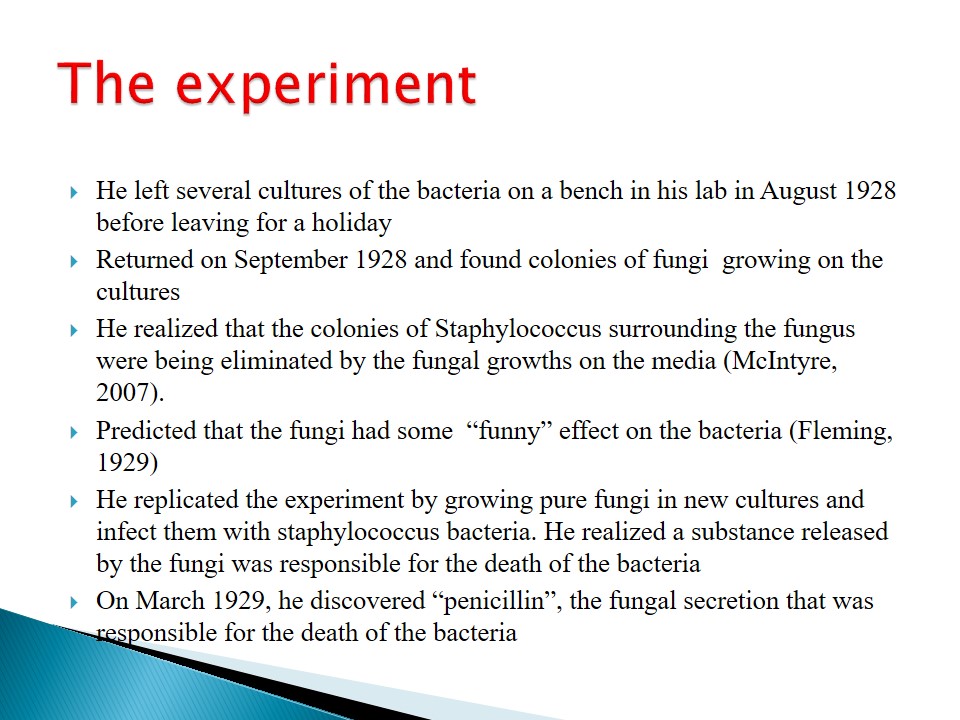
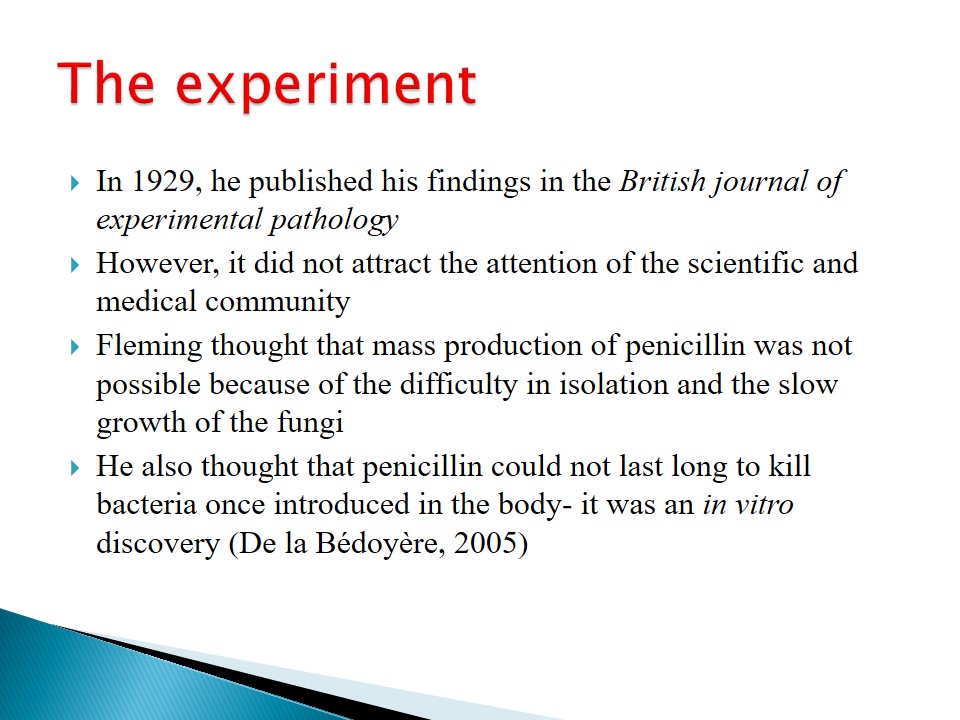
Theory and analysis
- Howard Florey and Ernst Chain repeated the experiment in 1930s.
- Chain and Edward Abraham researched more on the product and discovered how to isolate the product in vitro.
- Edward Abraham proposed the correct biochemical structure of the new product.
- Norman Hartley proposed the transfer of the active ingredient of the product into the water by altering the pH, which led to mass production.
- Successful clinical trials were carried out between 1940 and 1944.
- Almost all bacteria were killed in animals and humans.
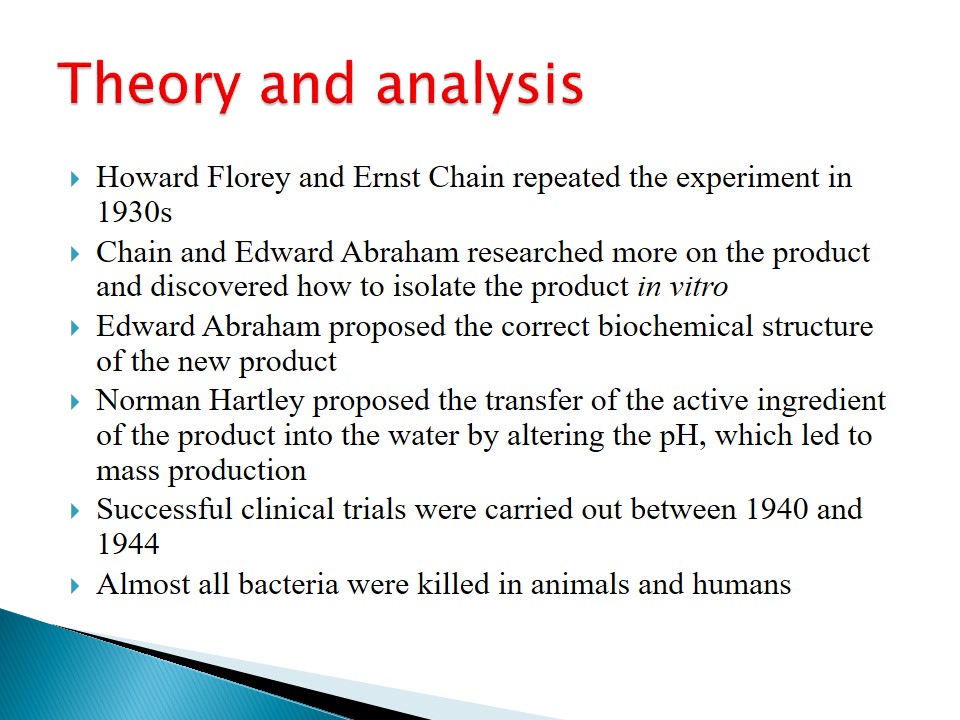
Effects of the discovery
- After the experiments by Howard, Chain, Abraham and Hartley, penicillin gained world-wide applause.
- Antibiotic drugs were produced in large masses to meet the demands of the WW2.
- By 1944, penicillin was being used to treat the allied forces with success (Sykes, 2001).
- It reduced the number of deaths during the war.
- Since then, penicillin-containing antibiotics have been used to treat various bacterial drugs, reducing the number of infections and deaths by a large percentage.
- The 1945 Nobel Price for Medicine and Physiology went to Fleming, Florey and Chain (Raju, 2009).
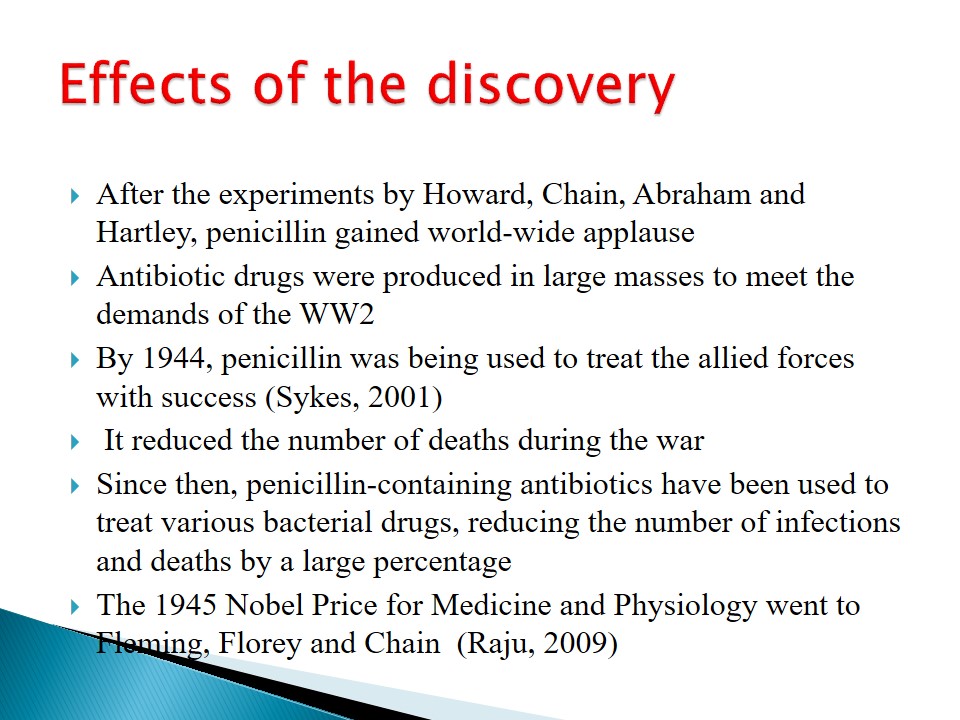
Reflection
- The scientific method used in the discovery of penicillin follows the normal culture experiment in the lab and controlled clinical trials discussed in class.
- First, a bacterial culture (accidentally) was infected with fungi Penicilliumspp (Landsberg, 1999).
- Penicillumspp produced penicillin secretions that prohibited the growth of bacteria in the media.
- Penicillum species colonies were transferred in a fresh medium and staphyloccocusspp introduced.
- The fungi prohibited the further growth of the bacteria.
- Penicillin was isolated from the fungi and tested in vitro with bacteria and the same observation made.
- The biochemical structure of penicillin was elucidated.
- Mass production of the product from the fungi species was done using under-the-water experiment.
- Laboratory animals were infected with penicillin (in vivo testing) (Radetsky, 2006).
- Controlled clinical trials were carried out with human participants.
- The penicillin was able to kill bacteria in vivo.
- Penicillin drugs were produced.
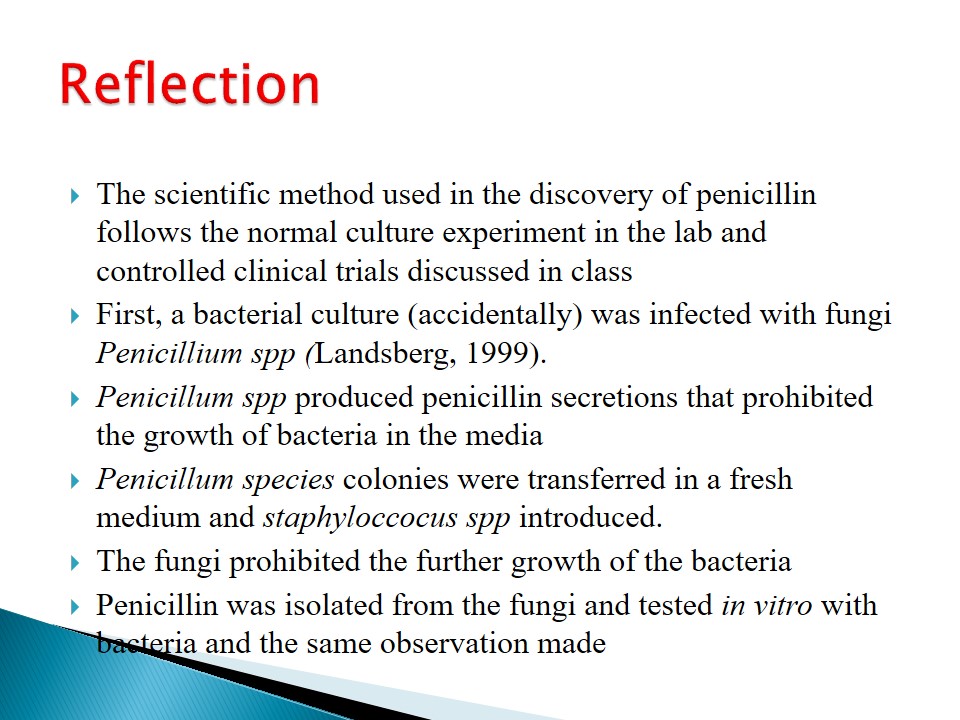
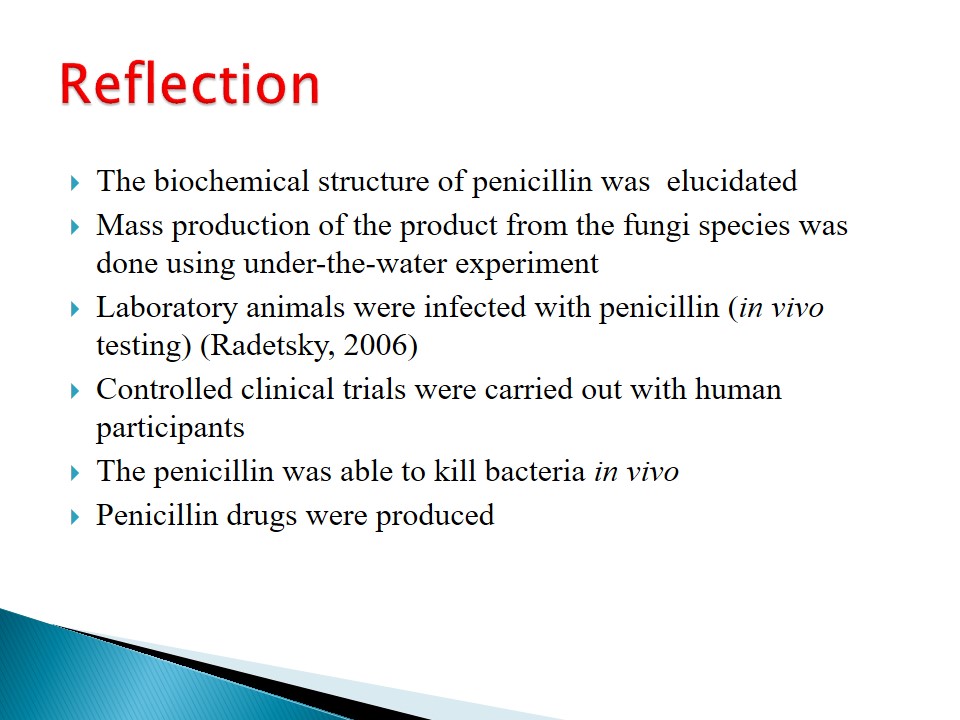
References
Bennett, J. W., & Chung, K. T. (2001). Alexander Fleming and the discovery of penicillin. Advances in applied microbiology, 49, 163-184.
De la Bédoyère, G. (2005). The Discovery of Penicillin. Evans Brothers.
Fleming, A. (1929). On the antibacterial action of cultures of a penicillium, with special reference to their use in the isolation of B. influenzae. British journal of experimental pathology, 10(3), 226.
Hugh, T. B. (2002). Howard Florey, Alexander Fleming and the fairy tale of penicillin. The Medical journal of Australia177(1), 52–53.
Landsberg, H. (1999). Prelude to the discovery of penicillin. Isis, 225-227.
Mazumdar, P. (2004). Fleming as Bacteriologist: Alexander Fleming. Science225(4667), 1140–1141.
McIntyre, N. (2007). Sir Alexander Fleming. Journal of medical biography15(4), 234.
Radetsky, M. (2006). The discovery of penicillin. The Pediatric infectious disease journal, 15(9), 811-818.
Raju, T. N. (2009). The Nobel chronicles. 1945: Sir Alexander Fleming (1881-1955); Sir Ernst Boris Chain (1906-79); and Baron Howard Walter Florey (1898-1968). Lancet353(9156), 936.
Sykes, R. (2001). Penicillin: from discovery to product. Bulletin of the World Health Organization, 79(8), 778-779.